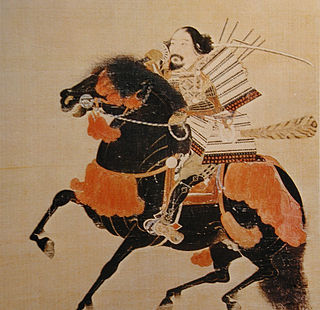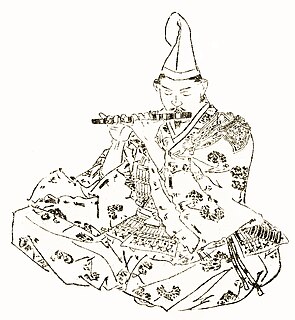Year 1338 (MCCCXXXVIII) was a common year starting on Thursday of the Julian calendar.

Ashikaga Yoshiharu was the twelfth shōgun of the Ashikaga shogunate who held the reins of supreme power from 1521 through 1546 during the late Muromachi period of Japan. He was the son of the eleventh shōgun Ashikaga Yoshizumi.His childhood name was Kameomaru (亀王丸).
The Ashikaga shogunate, also known as the Muromachi shogunate, was a dynasty originating from one of the plethora of Japanese daimyō which governed Japan from 1338 to 1573, the year in which Oda Nobunaga deposed Ashikaga Yoshiaki. The heads of government were the shōgun. Each was a member of the Ashikaga clan.

Ashikaga Yoshiaki was the 15th shōgun of the Ashikaga shogunate in Japan who reigned from 1568 to 1573. His father, Ashikaga Yoshiharu was the twelfth shōgun, and his brother, Ashikaga Yoshiteru was the thirteenth shōgun.
Ashikaga Yoshihide was the 14th shōgun of the Ashikaga shogunate who held nominal power for a few months in 1568 during the Muromachi period of Japan. When he became shōgun, he changed his name to Yoshinaga, but he is more conventionally recognized today by the name Yoshihide.

The Kenmu Restoration (1333–1336) is the name given to both the three-year period of Japanese history between the Kamakura period and the Muromachi period, and the political events that took place in it. The restoration was an effort made by Emperor Go-Daigo to bring the Imperial House back into power, thus restoring a civilian government after almost a century and a half of military rule. The attempted restoration ultimately failed and was replaced by the Ashikaga shogunate (1336–1575). This was to be the last time the Emperor had any power until the Meiji Restoration of 1868. The many and serious political errors made by the Imperial House during this three-year period were to have important repercussions in the following decades and end with the rise to power of the Ashikaga dynasty.

Ashikaga Takauji was the founder and first shōgun of the Ashikaga shogunate. His rule began in 1338, beginning the Muromachi period of Japan, and ended with his death in 1358. He was a descendant of the samurai of the (Minamoto) Seiwa Genji line who had settled in the Ashikaga area of Shimotsuke Province, in present-day Tochigi Prefecture.

The Nitta clan was one of several major families descended from the Seiwa Genji, and numbered among the chief enemies of the Hōjō clan regents, and later the Ashikaga shogunate. The common ancestor of the Nitta, Minamoto no Yoshishige, was the elder brother of Minamoto no Yoshiyasu, the common ancestor of the Ashikaga clan. Yoshishige was the a landowner in the Nitta District of Kōzuke Province in present-day Gunma Prefecture. Yoshishige supported Minamoto no Yoritomo in the Battle of Ishibashiyama of 1180 against the Taira clan.
Hosokawa Akiuji was a samurai general in the service of the Ashikaga Northern Court, during Japan's Nanboku-chō period.
The 1337 siege of Kanegasaki was the final battle for the Nitta family in their support of the Southern Imperial Court against the Ashikaga Pretenders of the Northern Court.
Prince Tsunenaga was one of the sons of Japanese Emperor Go-Daigo. He became involved in the Nanboku-chō wars between the true Imperial line and the Ashikaga clan.

Nitta Yoshioki (新田義興) was a samurai of the Nitta family who fought for the Southern Imperial Court in the Nanboku-chō period (1336–1392) of Japanese history.
Hōjō Tokiyuki was a samurai of the Hōjō clan who fought both for and against the Imperial Court. His father was Hōjō Takatoki, last Shogunal Regent and de facto ruler of the Kamakura shogunate.
Prince Takanaga (1310–1337) was the second son of Emperor Go-Daigo of Japan. He fought for his father in the Nanboku-chō Wars. Since the characters used to write "Takanaga" can also be read as "Takayoshi", the prince is sometimes known by that name as well.

Ashikaga Motouji (足利基氏) (1340–1367) was a warrior of the Nanboku-chō period. The fourth son of shōgun Ashikaga Takauji, he was the first of a dynasty of five Kantō kubō, Kamakura-based representatives in the vital Kamakura-fu of Kyoto's Ashikaga regime. Meant to stabilize a volatile situation in the Kantō, a region where many warrior clans wanted the return of the shogunate from Kyoto back to Kamakura, the dynasty he started almost immediately developed the ambition to usurp the shogunate, becoming a serious headache for the central government. Motouji was the only kubō who always remained loyal to the Kyoto government. During the Kannō disturbance, a historical episode with serious repercussions on his life, he tried to reconcile his father with his uncle Ashikaga Tadayoshi and, after his father's demise, he collaborated with his elder brother, shōgun Ashikaga Yoshiakira, to stabilize the shogunate. He died still young during an epidemic.
Yoshiaki is a masculine Japanese given name. Notable people with the name include:

Kanegasaki Shrine is a Shinto shrine located in the city of Tsuruga, Fukui, Japan. In the former Modern system of ranked Shinto Shrines, it was an imperial shrine of the second rank. Its main festival is held annually on May 6.
Events in the year 1336 in Japan.

Kanegasaki Castle was a Kamakura period yamashiro-style Japanese castle located in what is now part of the city of Tsuruga, Fukui Prefecture in the Hokuriku region of Honshu, Japan. It was also known as Tsuruga Castle. The site has been protected by the central government as a National Historic Site since 1934.











